|
WWW.ASTRONOMISCHE-REISEN.DE Ein Projekt der Reisebüro in der Südstadt GmbH Sitz Bonn - Amtsgericht Bonn HRB 4061 USt.-IdNr. DE122124664 Geschäftsführer Torsten Gissemann Argelanderstraße 55, D-53115 Bonn Tel.: 0228/26729-0; Fax: 0228/26729-90 serviceteam@reisebuero-suedstadt.de Tour-Info für Galapagos-Kreuzfahrt Roter Mond über Galapagos Reisedauer 8 Tage 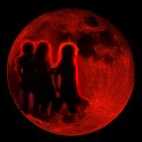
Lunar Eclipse onboard M/V Eclipse |
|
EINFÜHRUNG Das Motorschiff M/V Eclipse setzt für Galapagos neue Standards hinsichtlich Komfort und Eleganz. Trotz ihrer Größe nimmt sie nur 48 Passagiere an Bord (die Hälfte der üblichen Kapazität für diese Größe). Für je 12 Passagiere ist ein Naturführer vorgesehen, sodass bei Landgängen besondere Individualität gewährleistet ist. Pool, Poolbar, Shop, Bücherei, Video und Bordarzt ergänzen den Komfort. Das Schiff bietet Außenkabinen auf Bootsdeck und Hauptdeck. 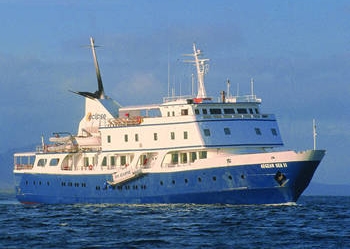 Am Abend des 16. Mai 2003 wird eine totale Mondfinsternis über den Galapagos-Inseln zu sehen sein. Da es hier kaum störende irdische Lichtquellen gibt, wird das astronomische Phänomen hier optimal zu beobachten sein. Die Bewölkungswahrscheinlichkeit ist dabei deutlich geringer als etwa in Mitteleuropa. Anlässlich dieses Ereignisses wird die M/V Eclipse ihrem Namen (eclipse ist das englische Wort für Finsternis) alle Ehre erweisen: Die Tour vom 10. - 17. Mai wird von dem Astronomen Randy Lisk begleitet werden. Er wird während der Kreuzfahrt sowohl mehrere Vorträge halten als auch abendliche Himmelsbeobachtungen anbieten. Und natürlich betreut er die Gäste aucch während der Beobachtung der totalen Mondfinsternis am Abend des 16.05.2003. INFORMATIONEN ZUR TOTALEN MONDFINSTERNIS AM 16.05.2003 Technische Daten der M/V Eclipse: Länge: 64 m Breite: 12,5 m Geschwindigkeit: 14,5 Knoten Kapazität: 48 Passagiere Kabinen: 27 Mannschaft: 23 + 4 Naturführer 
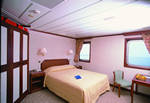


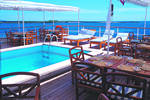
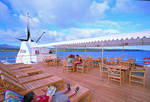
REISEVERLAUF Der nachstehend im englischen Originalwortlaut wiedergegebene Reiseverlauf ist ausdrücklich als Beispiel ("sample itinerary") zu verstehen. Kleinere Änderungen in der Routenführung, z.B. aufgrund der Wetterlage, sind durchaus möglich. 1. TAG: SAMSTAG, 10.05.03 Saturday Morning: Arrive at Baltra, Galapagos Upon arrival at Baltra travelers pass through an airport inspection point to insure that no foreign plants or animals are introduced to the islands and to pay the park entrance fee of $100 (unless prepaid). Guides will meet you, collect your luggage and escort you on the short bus ride to the harbor. Motorized rafts, called ‘Pangas’ will transport you to the M/V Eclipse and our crew will welcome you onboard. After departure and lunch, the first island visit is made. Saturday Afternoon: Santa Cruz (Indefatigable) Island—Las Bachas Beach A white sand beach that is a major egg-laying site for sea turtles, Las Bachas refers to the indentations left in the sand by egg laying turtles and departing hatchlings. On shore are marine iguanas, and, in the lagoon, flamingos are common. 2. TAG: SONNTAG, 11.05.03 Sunday Morning: Santiago (San Salvador, James) Island—James Bay This island has several sites to visit at the western end of James Bay. Puerto Egas with its black sand beaches was the site of small salt mining industry in the 1960s and a hike inland to the salt crater is an excellent opportunity to sight land birds such as finches, doves, and hawks. A walk down the rugged shoreline, especially at low tide, will turn up many marine species as iguanas basking on the rocks and sea lions lazing in the tide pools. At the end of the trail there is a series of grottoes or sea caves where fur seals and night herons are found resting on shady ledges. Just north of James Bay is Buccaneer Cove, a particularly scenic area of steep cliffs and dark beaches. Sunday Afternoon: Bartolome (Bartholomew) Island Bartolome is a small island that has beautiful white sand beaches, luxuriant green mangroves and a colony of penguins. Activities will include swimming and snorkeling and a climb to the summit of the island for one of the most breathtaking views in all the Galapagos. From the summit you will have the best view of the often-photographed Pinnacle Rock. 3. TAG: MONTAG, 12.05.03 Monday Morning: Tower (Genovesa) Island—Darwin Bay Beach Tower is a collapsed volcano and ships sail directly into its large breached caldera to anchor at the foot of the steep crater walls. Tower attracts vast numbers of pelagic seabirds that come here to nest and breed: great frigate birds, red-footed boobies, swallow-tailed gulls and storm petrels. A trail leads from a coral beach past tidal lagoons where lava gulls and yellow-crowned night herons are seen, then along the low shrubs populated by frigates and boobies, and eventually to a cliff edge where seabirds soar. Monday Afternoon: Tower (Genovesa) Island—Prince Philip’s Steps A second trail called Prince Philip Steps, leads to an open area for masked boobies, frigates, and red-footed boobies. At the end of this trail are thousands of band-rumped storm petrels at the cliff's edge, where they nest in crevices. Short-eared owls can sometimes be seen here, hunting the storm petrels during daylight hours. 4. TAG: DIENSTAG, 13.05.03 Tuesday Morning: Fernandina (Narborough) Island—Punta Espinosa Fernandina is the youngest and most active volcano in the Galapagos with eruptions taking place every few years. The flat lava of Punta Espinosa offers a stark and barren landscape, but here flightless cormorants build their nests on the point, sea lions sprawl on the beach or play in the tide pools and marine iguanas dot the sand. Tuesday Afternoon: Isabela (Albemarle) Island—Tagus Cove On the towering cliffs of Tagus Cove, 19th and early 20th century ships’ graffiti can be seen. After hiking beyond Darwin Lake, a saltwater lagoon above sea level, you will be rewarded with extraordinary views of Darwin and Wolf volcanoes. 5. TAG: MITTWOCH, 14.05.03 Wednesday Morning: Isabela (Albemarle) Island—Urbina Bay Urbina Bay is an easy wet landing on a gentle sloping beach. This area is very interesting in that it is a perfect example of the geological activity of the islands. In 1954 over 3 miles (5 kilometers) of the marine reef at the edge of the shore were uplifted by 13 feet (4 meters). Wednesday Afternoon: Isabela (Albemarle) Island—Elizabeth Bay At Elizabeth Bay enjoy a panga ride through the mangrove area to see the rays, turtles, sea lions, and, circling overhead, Galapagos hawks. A colony of penguins inhabit a rocky islet at the entrance to Elizabeth Bay. 6. TAG: DONNERSTAG, 15.05.03 Thursday: Santa Cruz (Indefatigable) Island—Puerto Ayora Town Santa Cruz is the only inhabited island to be visited during this Galapagos cruise. Puerto Ayora, with a population of about 10,000 people is the location of the Charles Darwin Research Station, world famous for its tortoise breeding programs. After touring the Station, journey by bus into the highlands to Los Gemelos the two deep pit craters situated in the Scalesia forest with lots of interesting bird life. Go for a walk through the giant lava tubes, visit the Tortoise Reserve to search for giant tortoises in their natural surroundings. There will be some free time to explore the town of Puerto Ayora on your own. 7. TAG: FREITAG, 16.05.03 - TOTALE MONDFINSTERNIS Friday Morning: Hood (Española) Island—Gardner Bay One of the oldest of the islands, Hood is small and flat with no visible volcanic crater or vent. Gardner Bay is on the eastern shore and has a magnificent beach. This beach is frequented by a transient colony of sea lions, and is a major nesting site for marine turtles. Around the small islets nearby, snorkelers will find lots of fish and sometimes turtles and sharks. On a trail leading to the western tip of the island you'll pass the only nesting sites in the Galapagos of the waved albatross, huge birds with a 6-foot wingspan. These huge birds nest here from April to December and represent the majority of the world’s population of this species. Friday Afternoon: Hood (Española) Island—Punta Suarez Punta Suarez is one of the most outstanding wildlife areas of the archipelago, with a long list of species found along its cliffs and sand or pebble beaches. In addition to five species of nesting seabirds there arethe curious and bold Hood Island mockingbirds, Galapagos doves and Galapagos hawks. Several types of reptiles, including the brilliantly colored marine iguana and the oversized lava lizard, are unique to this island. When heavy swells are running, Punta Suarez is also the site of a spectacular blowhole, with thundering spray shooting 30 yards into the air. Friday Evening: Observation of the total lunar eclipse 8. TAG: SAMSTAG, 17.05.03 Saturday Morning: Santa Cruz (Indefatigable) Island—Black Turtle Cove The panga will take you into a tidal lagoon to see three kinds of mangrove plants, red, white and black. White-tipped sharks, spotted rays, mustard rays and Pacific marine turtles frequent the waters here. WICHTIGER HINWEIS Für den Besuch der Galapagos-Inseln benötigen Sie einen Reisepass, der bei Einreise noch mindestens 6 Monate gültig ist. PREISE UND LEISTUNGEN REISEPREIS Bootsdeck, Suite (Kabinen 17 - 20): EUR 3639.- p.P. Bootsdeck, außen, Stateroom (Kabinen 21 - 28): EUR 3277.- p.P. Hauptdeck, außen, Doppel (Kabinen 3 - 14): EUR 2926.- p.P. Hauptdeck, außen, Doppel (Kabinen 15, 16): EUR 2634.- p.P. Hauptdeck, außen, Einzel (Kabinen 1, 2): EUR 3252.- p.P. IM REISEPREIS ENTHALTENE LEISTUNGEN - Kreuzfahrt gemäß Reisebeschreibung - Landgänge mit englischsprachigen Naturführen - Englischsprachige astronomische Reisebegleitung - Vollpension an Bord der M/V Eclipse - Die Festabende im Hotel - Alle Ausflüge mit Fahrtkosten, Eintrittsgeldern und Reiseleitung lt. Reiseprogramm - Astro-Infopaket - Bezug des "Newsletters zum Astro-Frühling 2003" (per e-mail) NICHT IM REISEPREIS ENTHALTENE LEISTUNGEN - Flüge nach Galapagos und zurück - Eintrittsgebühr Nationalpark Galapagos (z.Zt. US$ 100.-) - Getränke an der Bar der M/V Eclipse - Trinkgelder und Ausgaben persönlicher Natur |
| FENSTER SCHLIESSEN |